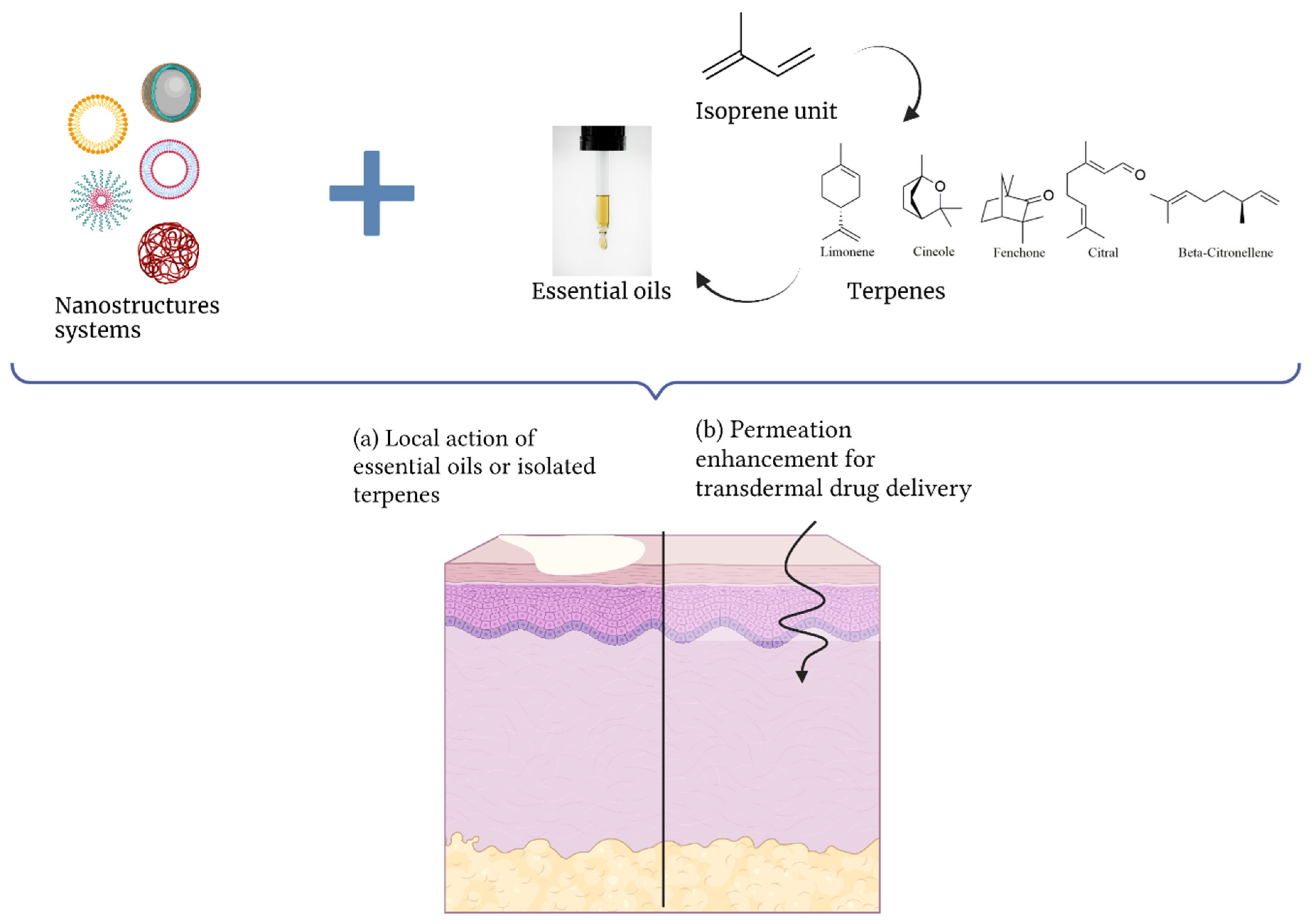Formulating Bioactive Terpenes
Funding
Acknowledgments
Conflicts of Interest
References
- Pinheiro, J.G.D.O.; Tavares, E.D.A.; Da Silva, S.S.; Silva, J.F.; De Carvalho, Y.M.B.G.; Ferreira, M.R.A.; Araújo, A.A.D.S.; Barbosa, E.G.; Pedrosa, M.D.F.F.; Soares, L.A.L.; et al. Inclusion Complexes of Copaiba (Copaifera multijuga Hayne) Oleoresin and Cyclodextrins: Physicochemical Characterization and Anti-Inflammatory Activity. Int. J. Mol. Sci. 2017, 18, 2388. [Google Scholar] [CrossRef] [PubMed] [Green Version]
- Barbosa, P.C.S.; Wiedemann, L.S.M.; Medeiros, R.D.S.; Sampaio, P.D.T.B.; Vieira, G.; da Veiga-Junior, V.F. Phytochemical Fingerprints of Copaiba Oils (Copaifera multijugaHayne) Determined by Multivariate Analysis. Chem. Biodivers. 2013, 10, 1350–1360. [Google Scholar] [CrossRef] [PubMed]
- de Oliveira, L.C.; de Menezes, D.L.B.; da Silva, V.C.; Lourenço, E.M.G.; Miranda, P.H.S.; Silva, M.D.J.A.D.; Lima, E.S.; Júnior, V.F.D.V.; Marreto, R.N.; Converti, A.; et al. In Silico Study, Physicochemical, and In Vitro Lipase Inhibitory Activity of α,β-Amyrenone Inclusion Complexes with Cyclodextrins. Int. J. Mol. Sci. 2021, 22, 9882. [Google Scholar] [CrossRef] [PubMed]
- Lucca, L.G.; De Matos, S.P.; De Mattos, C.B.; Teixeira, H.F.; Limberger, R.P.; Veiga, V.F.; De Araújo, B.V.; Koester, L.S. Nanoemulsification Potentiates In Vivo Antiedematogenic Effect of Copaiba Oil. J. Biomed. Nanotechnol. 2017, 13, 583–590. [Google Scholar] [CrossRef]
- Ibrahim, M.A.; Shazly, G.A.; Aleanizy, F.S.; Alqahtani, F.; Elosaily, G.M. Formulation and evaluation of docetaxel nanosuspensions: In-vitro evaluation and cytotoxicity. Saudi Pharm. J. 2019, 27, 49–55. [Google Scholar] [CrossRef] [PubMed]
- Masiero, J.F.; Barbosa, E.J.; Macedo, L.D.O.; de Souza, A.; Yukuyama, M.N.; Arantes, G.J.; Bou-Chacra, N.A. Vegetable oils in pharmaceutical and cosmetic lipid-based nanocarriers preparations. Ind. Crop. Prod. 2021, 170, 113838. [Google Scholar] [CrossRef]
- Jacob, S.; Nair, A.; Shah, J. Emerging role of nanosuspensions in drug delivery systems. Biomater. Res. 2020, 24, 1–16. [Google Scholar] [CrossRef] [PubMed] [Green Version]
- De Matos, S.P.; Teixeira, H.F.; De Lima, Á.A.N.; Veiga-Junior, V.F.; Koester, L.S. Essential Oils and Isolated Terpenes in Nanosystems Designed for Topical Administration: A Review. Biomolecules 2019, 9, 138. [Google Scholar] [CrossRef] [PubMed] [Green Version]
- Dias, D.D.O.; Colombo, M.; Kelmann, R.G.; De Souza, T.P.; Bassani, V.L.; Teixeira, H.F.; Veiga, V.F.; Limberger, R.P.; Koester, L.S. Optimization of headspace solid-phase microextraction for analysis of β-caryophyllene in a nanoemulsion dosage form prepared with copaiba (Copaifera multijuga Hayne) oil. Anal. Chim. Acta 2012, 721, 79–84. [Google Scholar] [CrossRef] [PubMed]
- Lucca, L.G.; de Matos, S.P.; Borille, B.T.; Dias, D.D.O.; Teixeira, H.F.; Veiga, V.F.; Limberger, R.P.; Koester, L.S. Determination of β-caryophyllene skin permeation/retention from crude copaiba oil (Copaifera multijuga Hayne) and respective oil-based nanoemulsion using a novel HS-GC/MS method. J. Pharm. Biomed. Anal. 2015, 104, 144–148. [Google Scholar] [CrossRef] [PubMed]
- Lucca, L.G.; De Matos, S.P.; Kreutz, T.; Teixeira, H.F.; Veiga, V.F.; De Araújo, B.V.; Limberger, R.P.; Koester, L.S. Anti-inflammatory Effect from a Hydrogel Containing Nanoemulsified Copaiba oil (Copaifera multijuga Hayne). AAPS PharmSciTech 2017, 19, 522–530. [Google Scholar] [CrossRef] [PubMed]
- Danielli, L.J.; De Souza, T.J.; Maciel, A.J.; Ferrão, M.F.; Fuentefria, A.M.; Apel, M.A. Influence of Monoterpenes in Biological Activities of Nectandra megapotamica (Spreng.) Mez Essential Oils. Biomolecules 2019, 9, 112. [Google Scholar] [CrossRef] [PubMed] [Green Version]
- Da Silva, G.N.S.; Primon-Barros, M.; Macedo, A.J.; Gnoatto, S.C.B. Triterpene Derivatives as Relevant Scaffold for New Antibiofilm Drugs. Biomolecules 2019, 9, 58. [Google Scholar] [CrossRef] [PubMed] [Green Version]
- Júnior, W.F.D.S.; De Menezes, D.L.B.; De Oliveira, L.C.; Koester, L.S.; De Almeida, P.D.O.; Lima, E.S.; De Azevedo, E.P.; Júnior, V.F.D.V.; De Lima, Á.A.N. Inclusion Complexes of β and HPβ-Cyclodextrin with α, β Amyrin and In Vitro Anti-Inflammatory Activity. Biomolecules 2019, 9, 241. [Google Scholar] [CrossRef] [PubMed] [Green Version]
- Yan, N.; Du, Y.; Liu, X.; Zhang, H.; Liu, Y.; Zhang, Z. A Review on Bioactivities of Tobacco Cembranoid Diterpenes. Biomolecules 2019, 9, 30. [Google Scholar] [CrossRef] [PubMed] [Green Version]
- Yuan, X.-L.; Mao, X.-X.; Du, Y.-M.; Yan, P.-Z.; Hou, X.-D.; Zhang, Z.-F. Anti-Tumor Activity of Cembranoid-Type Diterpenes Isolated from Nicotiana tabacum L. Biomolecules 2019, 9, 45. [Google Scholar] [CrossRef] [PubMed] [Green Version]
- Yang, Z.; Uhler, B.; Zheng, T.; Adams, K.M. Enzymatic Synthesis and Characterization of a Novel α-1→6-Glucosyl Rebaudioside C Derivative Sweetener. Biomolecules 2019, 9, 27. [Google Scholar] [CrossRef] [PubMed] [Green Version]

Publisher’s Note: MDPI stays neutral with regard to jurisdictional claims in published maps and institutional affiliations. |
© 2021 by the authors. Licensee MDPI, Basel, Switzerland. This article is an open access article distributed under the terms and conditions of the Creative Commons Attribution (CC BY) license (https://creativecommons.org/licenses/by/4.0/).
Share and Cite
Lima, Á.A.N.; Koester, L.S.; Veiga-Junior, V.F. Formulating Bioactive Terpenes. Biomolecules 2021, 11, 1745. https://doi.org/10.3390/biom11121745
Lima ÁAN, Koester LS, Veiga-Junior VF. Formulating Bioactive Terpenes. Biomolecules. 2021; 11(12):1745. https://doi.org/10.3390/biom11121745
Chicago/Turabian StyleLima, Ádley A. N., Letícia S. Koester, and Valdir F. Veiga-Junior. 2021. "Formulating Bioactive Terpenes" Biomolecules 11, no. 12: 1745. https://doi.org/10.3390/biom11121745
APA StyleLima, Á. A. N., Koester, L. S., & Veiga-Junior, V. F. (2021). Formulating Bioactive Terpenes. Biomolecules, 11(12), 1745. https://doi.org/10.3390/biom11121745






